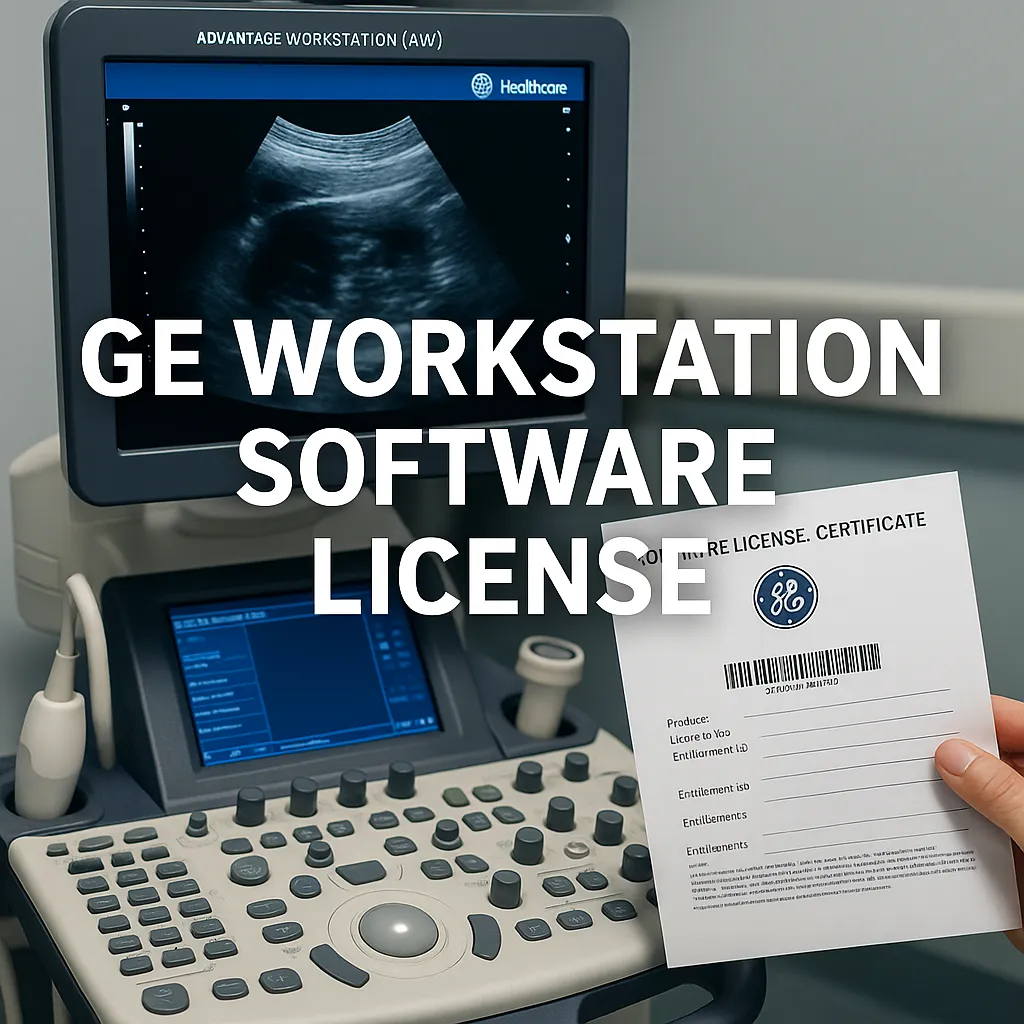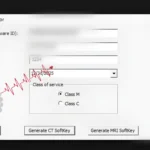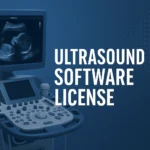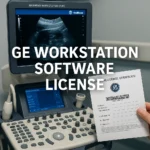Provider of Original Ultrasound Software License and OEM Legal Activation Keys
Looking for a trusted solution to keep your ultrasound systems compliant and fully functional? We provide:
Original ultrasound software license for a wide range of ultrasound equipment.
Legal activation keys issued under OEM terms for secure and reliable use.
Official updates and authorized support, ensuring your systems remain stable, audit-ready, and protected.
Our solutions are tailored to meet the needs of hospitals, clinics, and biomedical engineers—guaranteeing seamless performance for your devices.
📩 For details and pricing, connect with us via:
WhatsApp: +967775455559
Unlock the full potential of your ultrasound equipment with OEM-approved licensing today! 🌟
Introduction to ultrasound software
Imagine investing thousands in an advanced ultrasound machine—only to discover its ultrasound software fails mid-scan, updates are blocked, and support is nowhere to be found. For clinics and hospitals, this isn’t just a technical setback—it risks compliance, patient trust, and costly downtime. That’s why securing an original ultrasound software license is more than a purchase; it’s a safeguard for reliability, legal activation, official updates, and authorized OEM support. In this guide, we’ll uncover how authentic licensing protects your systems, ensures compatibility, and keeps your practice audit-ready.
Benefits of Buying Through Authorized Channels
When it comes to ultrasound systems, the ultrasound software license you choose directly affects reliability, compliance, and long-term value. Opting for an original ultrasound software license purchased through authorized channels ensures your organization receives legal activation keys, official updates, and access to OEM-level support. Below, we break down the three key benefits—compliance, reliability, and total cost of ownership—that make original licensing an essential safeguard for hospitals, clinics, and biomedical engineers.
Compliance & Audit Readiness
Purchasing ultrasound software through authorized channels guarantees that your license is traceable and compliant with OEM and regulatory requirements. This means you have the documentation needed to prove your software is original, legally obtained, and operating under the manufacturer’s terms. In an audit scenario—whether internal or from health authorities—having proper licenses avoids penalties, system lockouts, or even reputational damage for using unverified software.
For example, a European hospital faced a compliance audit in 2022 and was able to quickly provide certificates of authenticity and OEM purchase records. Because its licenses were original and legally sourced, the process was smooth, and the facility passed without fines. Unauthorized software, on the other hand, often lacks any verifiable entitlement, making compliance nearly impossible to prove.
Reliability, Uptime & Patient Safety Context
An original ultrasound software license ensures consistent system performance and minimizes downtime. OEMs issue validated patches, upgrades, and compatibility fixes that prevent unexpected crashes or lockouts during clinical use. Unauthorized versions may bypass these safety updates, leaving machines vulnerable to malfunctions at the worst possible time—such as in an emergency scan.
Consider a clinic using an older unauthorized key that failed during a routine obstetric ultrasound. The system froze, requiring a reboot, which delayed care and shook patient confidence. In contrast, an authorized license would have provided official patches to maintain uptime, ensuring the machine remained reliable during critical procedures. The difference isn’t just technical—it directly impacts patient trust and clinical outcomes.
Total Cost of Ownership
While unauthorized licenses may seem cheaper upfront, the long-term costs are significantly higher. With an original ultrasound software license, you benefit from reduced risk of device “bricking,” OEM-certified support, and predictable update cycles. This lowers the total cost of ownership by extending hardware life and avoiding expensive emergency interventions caused by unsupported systems.
For instance, a mid-sized imaging center in the U.S. reported saving 20% annually on service costs after switching to OEM-licensed software. Instead of paying for unexpected repairs or replacements, their machines ran smoothly with regular updates, and staff received timely technical support. Investing in an original license wasn’t just about compliance—it directly translated into financial savings and operational stability.
Compatibility & System Requirements (Versioning Matters)
Even the most advanced ultrasound software is only as good as the system it runs on. Purchasing an original ultrasound software license ensures compatibility across machines, operating environments, and IT frameworks. However, each OEM sets specific requirements tied to hardware, operating systems, and integrations. Understanding these factors before purchase prevents downtime, costly reconfigurations, or activation failures. Below, we examine supported devices, probes, operating systems, and hospital IT environments that must be considered.
Supported Devices & Modalities
Every OEM structures its licensing to align with particular ultrasound models and modalities. An original license ensures that your ultrasound software unlocks features only for the machines and probes it was designed for. For example, a license intended for a GE Voluson may not work on a Philips EPIQ system. Authorized channels verify this compatibility upfront, reducing the risk of purchasing a license that your equipment cannot use.
A hospital in the Middle East once acquired an unauthorized license, believing it would enable cardiac imaging on an existing ultrasound platform. Instead, the software failed to recognize the probe, leaving the cardiology department unable to conduct exams until a new OEM-issued license was purchased. This situation highlights why original licensing, verified against the exact model and modality, is critical for uninterrupted care.
OS, Drivers & IT Environment
Beyond hardware, ultrasound software must align with the IT environment in which it operates. An original license ensures that OEM updates remain compatible with hospital firewalls, antivirus solutions, and operating system versions. Many older systems still run on Windows 7 or Windows 10, while new releases are validated for Windows 11. Purchasing through authorized channels guarantees you’ll receive compatibility details upfront, avoiding the risk of installing unsupported software.
A clinic in the U.S. faced repeated crashes after using an unauthorized key to install ultrasound software on a workstation running outdated drivers. OEM support could not assist, since the system was not running a licensed environment. In contrast, had the clinic secured an official license, they would have received compatibility matrices, driver recommendations, and tested installation guides, ensuring seamless integration with their hospital IT policies and DICOM/PACS infrastructure.
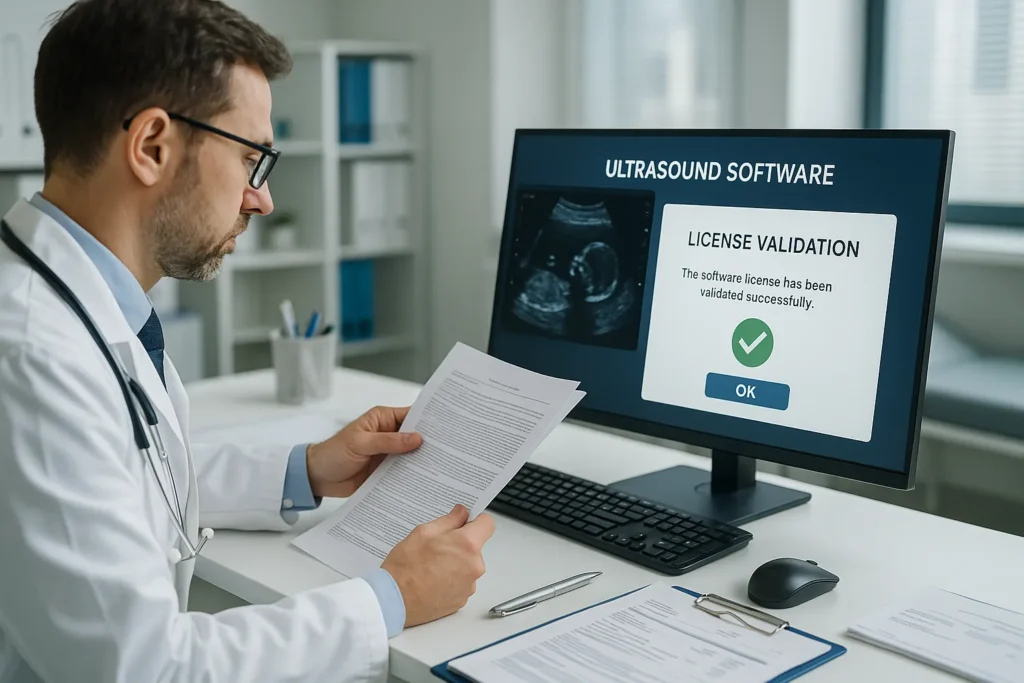
Safe Purchase Steps (How to Verify It’s Original & Legal)
Choosing an original ultrasound software license is not only about functionality—it’s about protecting your organization from risks associated with unauthorized products. To ensure your purchase is legitimate, every step from validation to documentation must be handled carefully. Following OEM guidance and authorized reseller processes helps clinics, hospitals, and biomedical engineers secure licenses that guarantee compliance, legal activation, and official support. Below are the essential steps to follow.
Pre-Purchase Validation
Before making any purchase, verify the legitimacy of the software and the seller. Authorized distributors should provide the OEM part number, version details, and entitlement terms. Request written proof of reseller authorization, such as certification or a direct reference on the OEM’s partner list. This ensures you are dealing with a verified channel and not a source of unauthorized keys.
For example, a large imaging center in Asia avoided a costly mistake when a reseller’s credentials were checked against the manufacturer’s database. The seller could not be verified as an OEM-approved partner, which saved the facility from purchasing software that would have left their machines unsupported. This demonstrates the importance of confirming legitimacy before committing funds.
Ordering Checklist
Once you confirm the source is legitimate, prepare an accurate ordering package. This typically includes your console ID or dongle ID, site details, and the modules or features you intend to activate. Providing incomplete or incorrect information can delay processing or lead to a license that won’t activate.
A U.S. hospital recently reported delays after providing the wrong console ID when ordering an OEM software license. The mistake meant the activation file was incompatible with their system, requiring additional turnaround time. By preparing a complete ordering checklist in advance, organizations can avoid such setbacks and ensure a smooth purchasing experience.
Post-Purchase Documentation
After purchase, ensure you receive all necessary documentation to confirm your license’s authenticity. This includes the official license certificate, activation instructions, and OEM support contact details. Original licenses often also include links to changelogs and update notices, which unauthorized versions cannot provide.
One biomedical engineer shared how their facility avoided disputes during a compliance inspection thanks to meticulous post-purchase documentation. The inspector was quickly satisfied with the OEM-issued certificate and activation record, proving the license was legitimate. Without these documents, the facility would have faced fines and potential system lockouts. Documentation is not just paperwork—it is your proof of compliance and protection against legal risk.
Official Activation & Onboarding
Purchasing an original ultrasound software license is only the first step; proper activation and onboarding ensure the license is usable, compliant, and fully supported. OEMs provide structured methods for activation, timelines to minimize downtime, and strict data privacy practices. Skipping these steps—or using unauthorized shortcuts—can cause costly disruptions and legal risk. Below, we outline the key elements of official activation and onboarding.
Activation Methods
Ultrasound software can be activated in several ways, depending on the OEM and license type. Common options include node-locked licenses tied to a specific console, USB dongle-based licenses, or floating licenses managed through a server. Each method requires official activation keys that align with the OEM’s entitlement system. Unauthorized methods, by contrast, often bypass these protections and risk system instability.
For example, a European radiology center used a legitimate dongle license provided by an authorized reseller. Activation took minutes, and the license was recognized instantly by the OEM server. In contrast, clinics that try to use cracked activations often experience “bricked” systems or error loops during updates. Choosing an official activation pathway avoids these operational and financial pitfalls.
Timeline & Downtime Minimization
A common concern among hospitals is how long activation will take and whether clinical workflows will be disrupted. OEM activation timelines are generally predictable—ranging from 24 to 72 hours depending on documentation completeness and system checks. Planning activation during off-peak hours or staging it on a non-clinical workstation helps minimize downtime.
One busy maternity clinic in North America scheduled activation over a weekend. Because they worked with an authorized reseller and provided complete details upfront, activation was finished within 24 hours. Their ultrasound systems were back online by Monday with minimal disruption. This example underscores how preparation and OEM alignment ensure smooth transitions without sacrificing patient care.
Data Privacy & Security
An often-overlooked aspect of activation is data privacy. Original licenses from OEMs never require patient health information (PHI) to be submitted for validation. Instead, activation relies on system IDs, dongles, or entitlement records. This ensures compliance with HIPAA and other international data protection standards. Unauthorized activation tools, however, may introduce malware or expose sensitive network data to third parties.
In 2021, a hospital IT team discovered that an unverified activation utility installed alongside an unauthorized license was attempting to transmit system data externally. This created a potential HIPAA breach and forced the facility to rebuild its network defenses. By contrast, OEM activation tools are digitally signed, encrypted, and rigorously tested for cybersecurity compliance—keeping both patient data and institutional networks safe.
Updates, Renewals & Authorized Support
Securing an original ultrasound software license is only the beginning—ongoing updates, renewals, and access to authorized support are critical for ensuring compliance, reliability, and long-term value. OEMs regularly release patches and version upgrades to enhance performance and security, while renewals keep your entitlement active. Authorized support ensures that when issues arise, your facility has direct access to expert help under official service-level agreements (SLAs).
Official Updates & Patch Policy
OEM-issued updates include bug fixes, security patches, and feature enhancements. These updates are tested for compatibility with specific ultrasound models, ensuring smooth integration into clinical environments. With an original license, customers gain direct access to these updates through official channels, minimizing the risk of system crashes or compatibility failures.
For example, a cardiology department in Europe benefited from a timely OEM patch that corrected probe recognition issues. Without the official update, scans would have been delayed and patients rescheduled. Unauthorized software cannot guarantee such patches, leaving systems vulnerable to recurring faults and potential security breaches.
Renewal & License Transfer
Licenses often come with an expiration period or require renewal when upgrading to newer software versions. Renewals extend your entitlement to updates, technical support, and compliance verification. OEMs also provide structured processes for transferring licenses to new hardware, such as when a hospital replaces aging ultrasound consoles. This ensures continuity without violating software agreements.
In one U.S. hospital, a license transfer was needed when upgrading from an older GE Voluson system to a newer model. Because they held an original license, the OEM facilitated the transfer seamlessly, saving both time and money. In contrast, unauthorized users often discover their licenses are locked to obsolete hardware, forcing a complete repurchase at a higher cost.
Support Tiers & SLAs
Authorized licenses unlock access to OEM support teams that provide troubleshooting, remote diagnostics, and escalation pathways. These support tiers often include guaranteed response times under SLAs, ensuring critical systems are restored quickly. OEM engineers also provide guidance for integrating ultrasound software with hospital IT systems, PACS, and data security frameworks.
For example, a maternity clinic in the Middle East relied on OEM support when facing recurrent system freezes. Within 48 hours, a remote diagnostic session identified the root cause, and a patch was deployed. With unauthorized software, the clinic would have had no access to this expertise, potentially prolonging downtime for weeks.
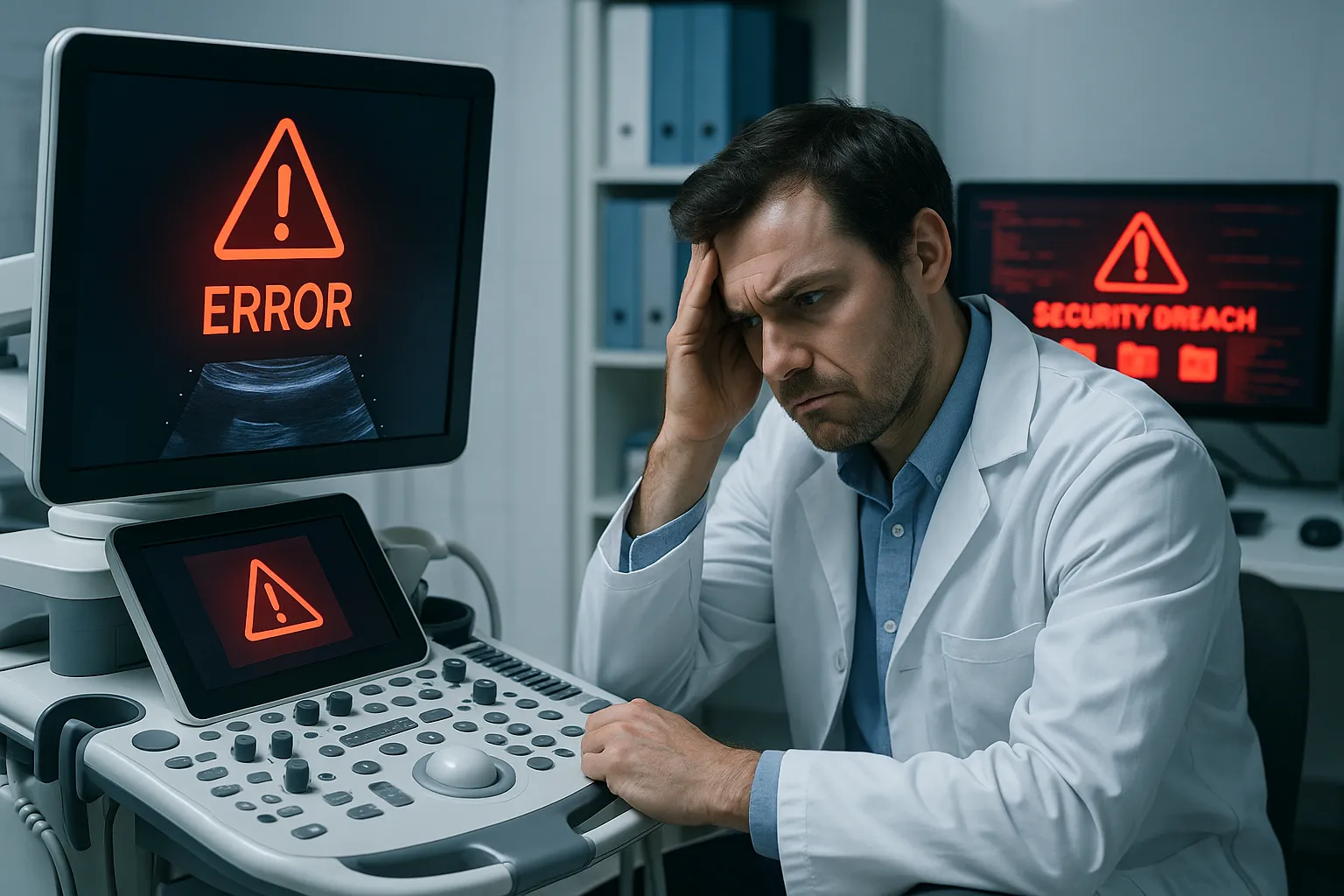
Risks of Unauthorized Keys (Why Avoid Cracks)
While unauthorized ultrasound software keys may seem like a shortcut to saving costs, they pose serious risks that go beyond technical failure. From loss of OEM support to potential data breaches and even permanent damage to medical devices, the consequences can be devastating. Understanding these risks underscores why only an original ultrasound software license ensures long-term reliability, compliance, and patient safety.
Loss of OEM Support
Unauthorized licenses immediately void eligibility for official updates and OEM support services. When issues arise—whether a malfunction or compatibility problem—OEM engineers cannot legally assist without a verified license. This leaves facilities vulnerable to extended downtime, costly repairs, or complete system replacement.
For example, a diagnostic imaging center in Latin America experienced repeated software lockouts on an unauthorized system. When the hospital approached the OEM, support was denied because the license was unverified. The center was forced to purchase a new original license, ultimately paying more than if they had purchased correctly from the start.
Legal & Compliance Exposure
Running unauthorized software exposes healthcare institutions to legal and regulatory consequences. Licensing audits or government inspections can identify unverified software, leading to fines, reputational harm, or loss of accreditation. Beyond financial penalties, unauthorized software can create compliance gaps with regulations like HIPAA, GDPR, or regional health authority requirements.
A European hospital faced compliance scrutiny after inspectors discovered software without OEM certificates. The audit escalated into legal proceedings, costing the facility both fines and trust with patients. By contrast, facilities with original licenses can quickly produce documentation, passing audits smoothly and maintaining a professional reputation.
System Instability & Device Bricking
Unauthorized activation keys often bypass OEM safeguards, leading to unstable performance. Updates may fail, systems may freeze mid-scan, or in worst cases, consoles may be permanently disabled (“bricked”). Such risks compromise patient safety by delaying or preventing diagnostic imaging during critical care situations.
In one case, an unauthorized license caused repeated system crashes during cardiac scans, requiring emergency intervention. Eventually, the ultrasound unit became unusable and had to be replaced entirely. Had the facility used an authorized license, they would have benefited from tested updates and official activation safeguards that ensure system stability.
Data Security & Malware Risks
Many unauthorized activation tools carry hidden malware or create vulnerabilities in hospital networks. These threats can expose sensitive patient data, violate privacy laws, and compromise broader IT infrastructure. Healthcare systems are already prime targets for cyberattacks, making unauthorized software an even greater liability.
For instance, a Middle Eastern hospital discovered that an unverified key installer contained malicious code transmitting system data to external servers. IT security teams were forced into an emergency shutdown to contain the breach, disrupting multiple departments. Original OEM activation tools, by contrast, are digitally signed and validated for cybersecurity compliance, protecting both machines and sensitive patient information.
Practical Scenarios & Implementation Tips
Securing and activating an original ultrasound software license is only part of the journey—how you implement it within your clinical or hospital environment makes the difference between smooth operations and unnecessary disruptions. By looking at practical scenarios, from new site setups to multi-facility rollouts, biomedical engineers and IT teams can learn best practices that ensure compliance, minimize downtime, and maximize long-term value.
New Site Setup
When opening a new clinic or imaging department, planning the licensing process early prevents costly delays. Procurement teams should coordinate with OEM-approved resellers to ensure licenses are aligned with installed hardware, selected probes, and the IT environment. Preparing documentation like console IDs and entitlement requests ahead of time ensures licenses are delivered on schedule.
For example, a women’s health clinic in North America launched with four new ultrasound systems. By working directly with an OEM reseller, all licenses were pre-validated, allowing machines to go live immediately after installation. This proactive approach avoided weeks of delays that often occur when licensing is treated as an afterthought.
Upgrade Path Example (From vX to vY)
Upgrading to a newer software version requires careful planning to protect existing configurations and ensure a smooth transition. Always back up system images and validate that probes, drivers, and IT integrations remain supported in the new release. Using original licenses guarantees you’ll receive OEM-provided rollback options in case of unexpected issues.
A cardiology department in Europe upgraded from Version X to Version Y of its ultrasound platform. Because the team followed OEM guidelines and used an official license, the transition was completed over a weekend with no data loss. Without these safeguards, unauthorized upgrades often result in system crashes or compatibility errors, leading to downtime during critical procedures.
Multi-Facility Rollout
Managing licenses across multiple hospitals or clinics requires centralized oversight. Facilities should maintain a license inventory, renewal calendar, and compliance dashboard to ensure all systems remain authorized and audit-ready. Original licenses make this possible because OEMs provide entitlement tracking and renewal reminders as part of their service.
One healthcare network in the Middle East rolled out licenses across 10 facilities. By using a centralized compliance system tied to OEM entitlements, administrators could track renewals and updates across all sites. This avoided gaps in support and ensured every machine passed compliance checks during an international accreditation review. Attempting such a rollout with unauthorized keys would have resulted in a logistical nightmare and compliance failures.
📊 Comparison Table: Practical Implementation Scenarios
| Scenario | Key Steps Involved | Common Risks if Ignored | Benefits of Original License |
|---|---|---|---|
| New Site Setup | Validate hardware & probes, prepare console IDs, order via OEM reseller | Delays in installation, incompatible software | Fast go-live, OEM pre-validation, audit-ready |
| Upgrade (vX → vY) | Backup system images, confirm compatibility, use OEM rollback procedures | Crashes, probe failures, unsupported IT drivers | Smooth upgrade, stable performance, OEM rollback options |
| Multi-Facility Rollout | Centralized license tracking, renewal scheduling, entitlement monitoring | Lost renewals, failed audits, inconsistent system versions | Compliance across sites, predictable renewals, OEM oversight |
FAQs (Schema-Ready)
Even when procurement teams and biomedical engineers understand the importance of an original ultrasound software license, there are always practical questions about verification, activation, updates, and compliance. To address the most common concerns, this FAQ section provides clear, concise answers that reflect real-world scenarios. Each response is based on OEM practices, compliance standards, and lessons learned from healthcare facilities worldwide.
How do I know a license is original and legal?
The simplest way to verify authenticity is to request an OEM-issued certificate of entitlement or license confirmation document. These certificates include unique identifiers tied to your console or dongle ID. OEM resellers also appear on official partner directories, which you can cross-check online.
For example, a radiology practice in Germany confirmed the authenticity of its software by referencing the serial number on the certificate against the OEM’s portal. The process took minutes and provided full assurance during an internal compliance audit.
Which documents prove authorized licensing?
Authorized licenses are always accompanied by OEM documentation, including an entitlement certificate, activation guide, and proof of purchase from a verified reseller. These documents serve as legal evidence in audits and protect your organization if licensing disputes arise.
In one compliance review, a U.S. hospital was asked to produce proof of software authenticity. The team presented OEM-issued documents, which were accepted immediately, allowing the audit to close without further questions. Unauthorized keys cannot provide such verifiable records, leaving facilities exposed.
What if activation fails?
Activation failures are rare with original licenses but can occur if incorrect console IDs or system details were provided during ordering. In such cases, OEM support teams quickly resolve the issue by reissuing activation files or guiding engineers through the process.
A maternity clinic in the Middle East experienced an activation error due to a typo in the console ID. Because the license was official, the OEM corrected the file within 24 hours, allowing the system to function without disruption. Unauthorized licenses offer no such remedy.
How are official updates delivered?
Official updates are delivered directly from the OEM, either through online portals or secure offline installation media. Updates include security patches, feature enhancements, and validated compatibility fixes to ensure safe and compliant operations.
For example, a cardiology department in France used an OEM update portal to download and apply patches that improved probe recognition accuracy. Unauthorized users, lacking access to these updates, would remain vulnerable to ongoing system errors and potential compliance failures.
Can I move the license to new hardware?
Yes, OEMs provide structured processes for license transfer when ultrasound systems are upgraded or replaced. This requires submitting a formal request along with hardware details, after which the OEM issues a transfer license tied to the new system.
In practice, a U.S. hospital replaced aging consoles and successfully transferred licenses without needing to repurchase them. The process took less than a week and allowed the hospital to remain compliant while modernizing its imaging equipment.
Does activation expose patient data?
No, original ultrasound software licenses never require patient health information (PHI) for activation. The process relies solely on system identifiers such as console IDs or dongle IDs, ensuring compliance with HIPAA and GDPR requirements.
A hospital IT team in the UK confirmed this when onboarding new software: activation required only hardware details, and no clinical data ever left the system. Unauthorized tools, however, often introduce malware that may compromise patient records, highlighting the risks of non-OEM solutions.
Regulatory & Legal Notice (Informational Only)
When discussing the purchase and activation of an original ultrasound software license, it is critical to place these processes within the context of regulatory and legal frameworks. Healthcare organizations operate under strict oversight to protect patient safety, data privacy, and compliance with international standards. This section highlights the legal boundaries, intellectual property considerations, and data protection requirements that must be respected when acquiring and using medical device software.
Informational Use Disclaimer
All content in this article is intended for educational and informational purposes only. It is written to assist biomedical engineers, IT administrators, and procurement teams in understanding the importance of licensed medical device software. It should not be considered medical, legal, or regulatory advice, and decisions should always be based on direct consultation with OEMs and regulatory authorities.
For example, a hospital in Canada sought legal advice before implementing a new software license strategy to ensure compliance with national regulations. This proactive step helped the facility align procurement with both OEM terms and federal standards, demonstrating the value of treating this guidance as informational rather than directive.
Intellectual Property & OEM Terms
Ultrasound software licenses are intellectual property owned by the original equipment manufacturers (OEMs). Using unauthorized keys or cracked software constitutes a violation of intellectual property rights and may result in penalties, contract termination, or litigation. By purchasing through authorized channels, healthcare facilities agree to abide by OEM terms, which define how licenses can be activated, transferred, or renewed.
An imaging center in the UK once faced legal action after installing unauthorized software across multiple ultrasound consoles. The OEM pursued intellectual property enforcement, resulting in fines and reputational damage. By contrast, organizations that respect OEM terms and acquire original licenses enjoy legal protection and ongoing access to updates and support.
Data Privacy & Security Obligations
Healthcare organizations must ensure that all software integrations protect sensitive patient data. Original licenses from OEMs are designed to comply with privacy frameworks such as HIPAA, GDPR, and regional health authority standards. Unauthorized activation tools, however, may bypass these safeguards, potentially exposing patient health information (PHI) to cyber risks.
For instance, a hospital in the Middle East faced a near data breach after installing unauthorized software that attempted to connect with external servers. The IT department intervened before patient data was compromised, but the incident reinforced the importance of sticking to OEM-approved tools that are tested and certified for data privacy compliance.
Call to Action
After understanding the benefits of an original ultrasound software license, from compliance and security to OEM support and patient safety, the next step is to act with confidence. Whether you are a biomedical engineer, procurement officer, or hospital administrator, taking proactive steps now ensures your facility remains audit-ready, operationally efficient, and legally protected. Below are the key actions you should consider today.
Request OEM Pricing & Verification
Start by requesting a pricing quote for original licenses tailored to your specific ultrasound systems. OEM-approved resellers can provide detailed information about license costs, supported versions, and any renewal or upgrade requirements. Verification of reseller credentials is equally important to avoid falling into the trap of unauthorized keys.
For example, a large teaching hospital in the U.S. streamlined procurement by asking for OEM-backed verification alongside pricing. This not only secured the best value but also provided reassurance that the licenses would pass any future compliance audit.
Schedule a Technical Consultation
Beyond cost, a technical consultation helps identify compatibility requirements and ensures smooth deployment. Engineers can confirm whether your ultrasound consoles, probes, and IT environment meet OEM standards before purchase. This reduces the risk of downtime caused by overlooked compatibility gaps or missing prerequisites.
A clinic in Europe avoided weeks of disruption by scheduling a consult before purchase. The OEM reseller flagged an operating system mismatch, allowing the IT team to update workstations ahead of activation. This proactive approach saved time, minimized risk, and ensured a successful rollout.
Secure Legal Activation & Long-Term Support
Once you’ve confirmed pricing and compatibility, the next step is securing legal activation. Official activation guarantees that your systems remain stable, updated, and eligible for OEM support. Long-term benefits include reliable performance, predictable renewal schedules, and faster resolution in case of technical issues.
A hospital network in the Middle East reported that after switching from unauthorized to original licenses, support tickets were resolved twice as fast. With direct access to OEM-certified engineers, they reduced downtime and built stronger confidence among clinical staff relying on ultrasound diagnostics daily.
Contact Us Today
To begin your journey toward reliable, compliant, and officially supported ultrasound software, connect with our team today:
📞 +967775455559
💬 https://wa.me/message/NRDFVKNYDTUNM1
Take the first step now to protect your systems, your patients, and your reputation with authentic, OEM-approved solutions.
📝 Conclusion to ultrasound software
Securing an original ultrasound software license is more than a procurement decision—it is an investment in compliance, patient safety, and operational reliability. From legal activation and official updates to seamless renewals and OEM-certified support, original licenses ensure your ultrasound systems remain dependable and audit-ready. By choosing authorized channels, hospitals and clinics not only protect their technology but also reinforce trust with patients and regulatory authorities.
Securing an original ultrasound software license delivers far more than functionality—it safeguards compliance, ensures reliable uptime, and provides access to official updates and OEM-certified support. From smooth activation and renewals to protecting patient data and passing audits with confidence, every section of this guide highlights why authorized licensing is essential for hospitals and clinics. Don’t risk system instability or legal exposure with shortcuts—choose the path of authenticity. Take action today to verify your licenses, protect your patients, and future-proof your technology investments.
Also read about information on MRI Software License Price: OEM Bundle Guide – BME Service
, click here. (https://bmeser.com/mri-software-license-price/)



